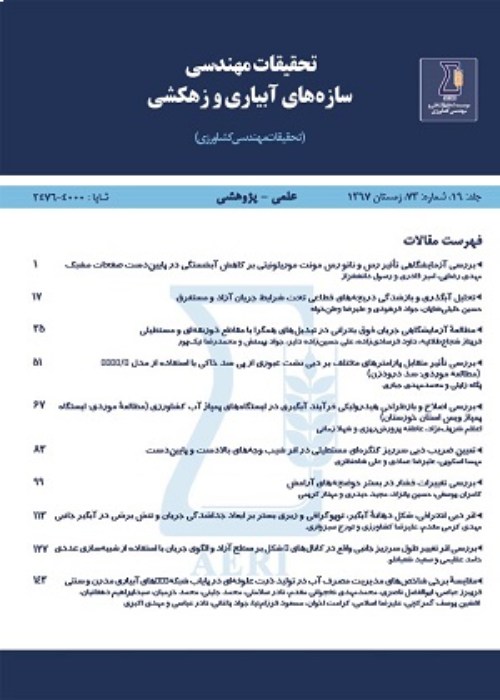Numerical investigation of the cylindrical bridge pier scour reduction by installing a group of two submerged vanes
The construction of hydraulic structures such as bridge piers in river beds changes the hydrodynamics of the flow and is associated with the scouring phenomenon. This process has been investigated by many researchers with numerical and laboratory methods. The implementation of scouring reduction measures has also been considered in addition to investigating this phenomenon, due to the destructive changes of scouring on the morphology and the river bed shape. In general, these measures are divided into two general categories, direct and indirect, which the use of submerged vanes is one of these reduction measures. Based on less attention to this scour reduction measure; in this study, the effect of a group of two submerged vanes on reducing scour around the cylindrical bridge pier with a numerical approach of the FLOW-3D model is investigated. Dimensional analysis showed that the position angle of the vanes, the location, and the height of the vanes are effective parameters. According to the results, the installation of submerged vanes in all cases reduces scour and the position angle of 30 degrees, in location 0D,1D,2D, and the height of the vanes equal to the sedimentary bed leads to the greatest reduction of scour.
In this research, the flow-3d numerical model has been utilized to analyze the scouring phenomenon around the cylindrical bridge pier. In order to validate the numerical model, first, the sensitivity of the mesh dimensions was performed and the 8.5 mm mesh size was selected. Then the analysis of the geometric model for the bridge pier was conducted with different turbulence models k-ε, k-ε RNG, and LES, and the numerical results were compared with experimental data. It was found that the numerical results of the LES model are the most consistent with the experimental data, so this turbulence model has been used for the conditions of bridge pier with submerged vanes. Different times for scour hole development were investigated to determine the processing time of the numerical model and the computational cost, and finally, it was observed that the scour equilibrium time of 500 seconds is suitable for numerical analysis, and after this time the maximum scour values remain almost constant.
By increasing the position angle of the two submerged vanes up to 30 degrees, the amount of scour depth decreases. But by increasing it by 30 degrees, this trend decreases and does not follow a specific trend. The most suitable position of the group of two submerged vanes is in 0D,1D,2D location, and the location of 2D,3D,4D has the least effect, which reduces the distance between the vanes from the upstream of the channel to the bridge pier, the separation point of boundary layer moves to the bridge pier, thus reducing the thickness of the boundary layer. Therefore, by reducing the distance between the vanes and the bridge pier, the intensity of shear stress to dig bed sediments around the bridge pier is reduced and as a result, the effect of submerged vanes and their protection from erodible bed against scouring phenomenon increases. It was found that the presence of submerged vanes in all cases reduces the maximum scour depth, but this amount of reduction is not the same due to the different positions of the vanes. Observing the flow pattern, it can be concluded that the velocity upstream of the pier is negative and rotational flows are formed in this region, which are the horseshoe vortices that are one of the reasons for the formation of scouring holes.
In all cases of installation of submerged vanes before bridge pier, scour depth was reduced because the presence of vanes caused local scouring around the vane itself and the washed sediment particles were transported by the flow to the scour hole created upstream around the bridge pier. On the other hand, in all locations, by increasing the position angle of the two submerged vanes, the transverse area is more affected by the two vanes, and a stronger drag force is applied to them. In other words, the resistance to current increases, the flow moves away from the bridge pier, and also fewer bed particles are transported around the bridge pier. As the height of the vanes increases, the intensity of the flow colliding with the vanes increases, and as a result, the amount of scouring depth upstream of the vanes increases, and despite the reduction of scouring upstream of the bridge pier, the performance of these vanes decreases.
- حق عضویت دریافتی صرف حمایت از نشریات عضو و نگهداری، تکمیل و توسعه مگیران میشود.
- پرداخت حق اشتراک و دانلود مقالات اجازه بازنشر آن در سایر رسانههای چاپی و دیجیتال را به کاربر نمیدهد.


